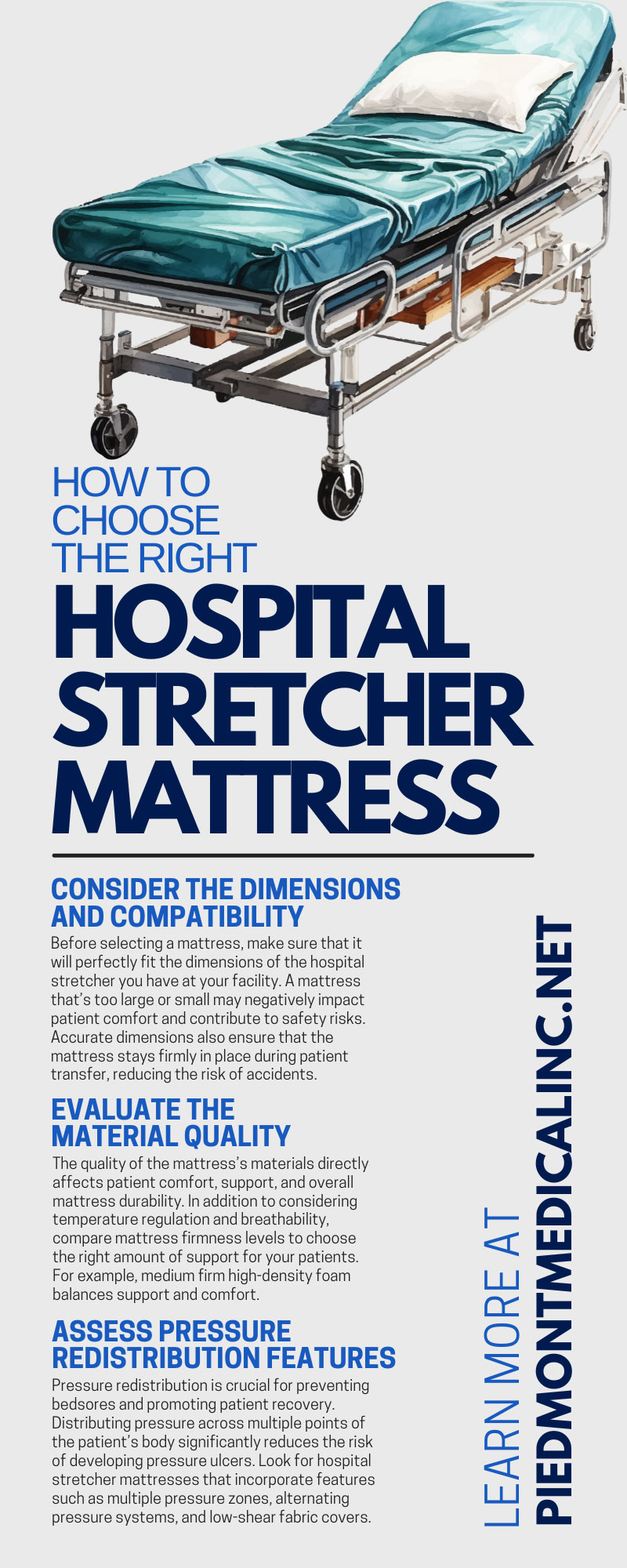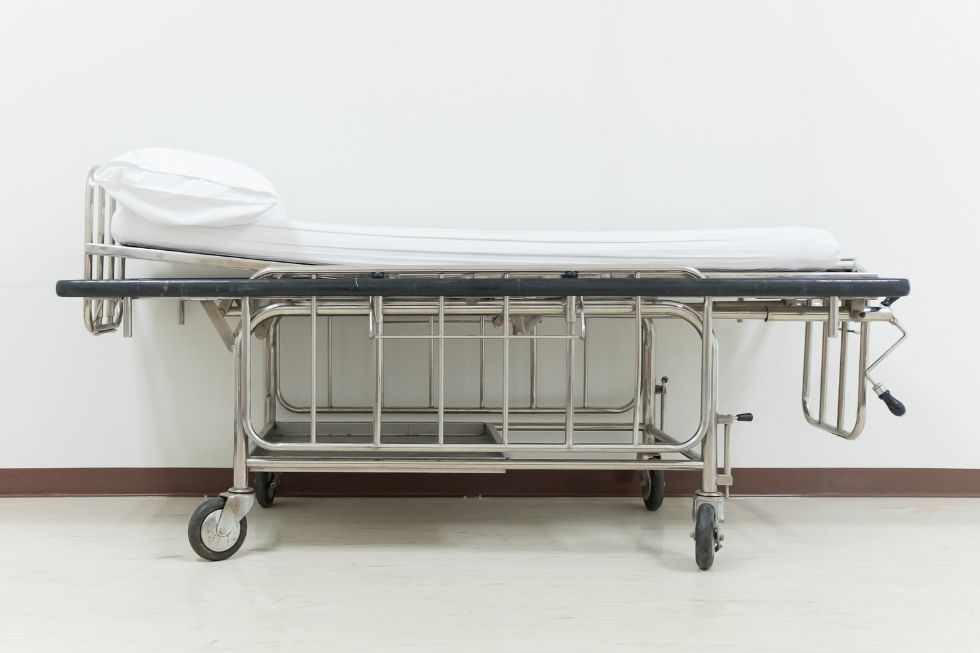Stretchers ensure safe patient transportation within medical facilities. A stretcher offers a secure and stable platform, reducing the risk of injury and improving patient comfort. Moreover, stretchers help healthcare professionals efficiently move patients, improving timely access to necessary treatments and procedures. Discover some invaluable tips on how to choose the right hospital stretcher mattress to maximize its intended use.
Tip 1: Consider the Dimensions and Compatibility
Before selecting a mattress, make sure that it will perfectly fit the dimensions of the hospital stretcher you have at your facility. A mattress that’s too large or small may negatively impact patient comfort and contribute to safety risks. Accurate dimensions also ensure that the mattress stays firmly in place during patient transfer, reducing the risk of accidents.
Additionally, confirm the mattress’s compatibility with your specific stretcher model, as some stretchers may have unique features or requirements. A mismatch between the stretcher and mattress can hinder the functionality of the stretcher’s features, such as tilting, folding, or height adjustment. Compatibility also includes the mattress’s ability to work seamlessly with any integrated technologies in the stretcher, like heating systems or patient monitoring devices.
Tip 2: Evaluate the Material Quality
The quality of the mattress’s materials directly affects patient comfort, support, and overall mattress durability. In addition to considering temperature regulation and breathability, compare mattress firmness levels to choose the right amount of support for your patients. For example, medium firm high-density foam balances support and comfort.
As for outer materials, electrically conductive vinyl helps control electrostatic discharge by preventing static charge from accumulating. This protects patients from electrical currents that could interfere with medical equipment. These mattresses also provide latex-free pads that offer bacteria and fluid resistance for gurney and transport stretchers.
Weigh the pros and cons of the mattress’s construction and consider the specific needs of your healthcare facility and patients to make an informed decision. Manufacturers can also produce custom stretcher pads made to your specifications. Consider customizing the thickness, choice of foam, or vinyl covering to obtain the ideal stretcher mattresses for your facility.
Tip 3: Assess Pressure Redistribution Features
Pressure redistribution is crucial for preventing bedsores and promoting patient recovery. Distributing pressure across multiple points of the patient’s body significantly reduces the risk of developing pressure ulcers. Look for hospital stretcher mattresses that incorporate features such as multiple pressure zones, alternating pressure systems, and low-shear fabric covers.
By reducing the concentrated pressure on specific areas of the body, the mattress improves blood flow, preventing tissue damage. Additionally, pressure redistribution promotes proper circulation, allowing oxygen and vital nutrients to reach the tissues and aiding in the prevention of skin breakdown.
Pro Tip: Use Low-Shear Fabric Covers
Pressure, friction, and shear are three factors that contribute to the formation of bedsores. Shear may occur when repositioning a patient on the mattress pulls the patient’s skin in opposite directions. Low-shear fabric on the stretcher mattress will reduce friction between the patient’s skin and the surface of the mattress, minimizing the risk of skin breakdown and pressure ulcers.
Tip 4: Prioritize Infection Control
Another tip for choosing the right hospital stretcher mattress is to select materials designed to minimize the risk of bacterial and microbial growth. Infection control in healthcare settings prevents the transmission of disease, safeguards patient health, and maintains a safe working environment for staff. By incorporating waterproof and antimicrobial materials, as well as facilitating ease of sanitization, these mattresses function as an essential tool in enhancing cleanliness and driving down the risk of hospital-acquired infections.
Antimicrobial mattress covers can actively inhibit the growth of bacteria, fungi, and other microorganisms, significantly reducing the potential for cross-contamination. Quality mattresses can make a significant difference in preventing healthcare-associated infections, adding a robust line of defense in the fight against disease transmission.
Pro Tip: Consider Ease of Cleaning and Maintenance
A hospital environment demands strict hygiene standards, so be sure to select a mattress that is easy to clean and maintain. Features like removable covers, washable materials, and stain-resistant properties contribute to the mattress’s overall cleanliness. Materials that staff can easily sanitize allow for more effective and frequent cleaning, which is crucial in high-turnover environments.
Tip 5: Assess Weight Capacity and Durability
Hospital patients come in all sizes, making it crucial to choose a stretcher mattress that can handle varying weights. Consider the weight capacity of the mattress and its material strength to ensure it can withstand daily usage. Additionally, pay close attention to the warranty information to understand the product’s quality. A mattress unable to support the weight of heavier patients can lead to discomfort and increased risks of pressure sores, compromising patient care quality.
Furthermore, durability is vital as a stretcher mattress undergoes numerous cleanings and is subject to a certain level of wear and tear throughout its lifecycle. A durable, high-weight capacity mattress can be a cost-effective investment for healthcare facilities, resulting in less frequent replacements and improved patient satisfaction.
Tip 6: Consider Budget and Value for Money
Though it’s tempting to pick the cheapest available option, it’s important to balance budget constraints with quality and value. Consider the long-term benefits of investing in a quality mattress, such as the potential for fewer replacements and reduced maintenance costs. Assess warranty coverage and customer reviews to gauge the product’s reliability and satisfaction levels among other medical professionals.
Pro Tip: Stretch Your Budget With Reconditioned Medical Stretchers
You can maximize your budget without compromising on quality with reconditioned medical stretchers. These stretchers undergo a thorough reconditioning process that ensures they meet industry standards. These like-new stretchers can save healthcare facilities a significant amount of money compared to purchasing brand-new ones. Not only does this help stretch limited resources further, but it also allows hospitals more flexibility in allocating funds.
When shopping for hospital stretcher mattresses, consider dimensions, material quality, pressure redistribution features, infection control, weight capacity, durability, patient comfort, and budget. Each of these elements plays a critical role in maximizing the functionality of the stretcher while ensuring the safety and comfort of patients. Quality mattresses facilitate patient recovery, prevent complications, and enhance the efficiency of healthcare delivery. Therefore, buying a quality stretcher mattress is not merely a purchase but a long-term investment in patient care and healthcare quality.



Recent Comments